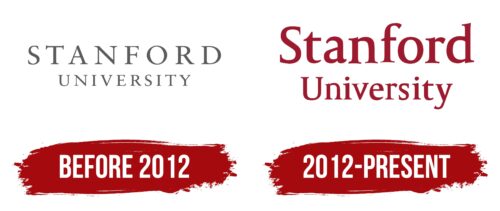The Stanford University logo consists only of the university’s name; it does not seem monotonous because the burgundy color fills the inscription with inner strength. At the same time, a strict serif typeface looks stylish and presentable. Asymmetric lines make the wordmark dynamic because development is impossible without movement, and the educational institution is constantly growing and improving.
Stanford University: Brand overview
Stanford is a higher education institution located in Stanford, California. Its full name is Stanford University or Leland Stanford Junior University. It is a private educational and research institution that was founded in 1885. Its creators are the spouses of Stanford (Leland and Jane). They opened a university in honor of their 15-year-old son, who died of typhoid fever. Today, it is one of the best universities globally, with an annual income of over $1 billion.
Even though Stanford University was founded in 1885, it opened in 1891. Its location was the former Palo Alto farm, which belonged to the Stanford family. The institution was modeled on Cornell University, providing higher education to men and women on an equal footing, which was not the case until then. Following the great Eastern universities’ example, it abandoned sectarianism, providing an open educational process based on scientific achievements rather than religious dogma.
In 1893, Leland Stanford died, and the university’s future was questioned since a financial lawsuit was brought against him. But Jane insisted on continuing to operate despite the crisis. The next major test was the 1906 earthquake in San Francisco. Educational buildings and other buildings were badly damaged. Some buildings have been restored, and some have not, as they were beyond repair.
Modern Stanford University includes seven schools. Three of them teach bachelor’s and consist of forty departments, and four graduate masters in education, medicine, law, and business. In addition, the university has its own Stanford Cardinal sports club, which includes 36 teams participating in the Division I FBS Pac-12 Conference. They have won 128 NCAA championships and the NACDA Directors Cup for a quarter of a century since 1994/1995. Alumni and students have also won 270 Olympic medals, 139 of which are gold.
As of 2021, the university had 84 Nobel Prize winners and 29 Turing Award winners. So, the Stanford emblem is widely recognized and highly prestigious.
Meaning and History
The Stanford University logo has long contained the institution’s name. Until 2012, the inscription was painted gray in a serif capital font. Then, the designers experimented with the design and repainted both words in dark red. The shape of the letters has also changed: they have become more massive, even though many have been converted to lowercase.
The university’s identity is represented by three components: the seal, the main logo, and the mark of the sports department.
The university seal is a rondel – a classic circle with a central part where the key symbol is placed. In this case, it is a single spruce against the background of hills. It has a strong root system that represents a long historical connection with the area. On both sides of the tree, there is an inscription in German, indicating the motto of the higher educational institution: on the left – “DIE LUFT DER,” and on the right – “FREIHEIT WEHT.”
The central circle is surrounded by double edging – thin lines of different sizes with a small gap between them. This is followed by a wide white stripe, on which is the full name of the university, “Leland Stanford Junior University,” the year of its opening (1891), and six stars (three on each side of the significant date). The edge is edged as a geometric ornament consisting of a chain of small rhombuses.
The logo contains the name Stanford University. It is printed in lowercase, except the first letters, which are capitalized according to the spelling. The letters have miniature serifs. At “t,” the bar is shifted to the right, which is longer than the left. The “f” apex is more curved than usual. The logo’s color palette is identical to the print color.
What is Stanford University?
It is an educational and research institution founded in honor of Leland Stanford Jr., who died of typhoid fever. In this way, his parents immortalized his memory. The university was formed in 1891 and is now considered one of the most prestigious in the world.
before 2012
Previously, the name Stanford University looked faded and inexpressive because it was gray. The designers created the contrast only by splitting the words into two lines with center alignment and reducing the letters in the second row. In addition, a dynamic font with different stroke thicknesses and sweeping serifs was used for the inscription, as in Magneta Medium from Positype or Bamberg Serial Regular from SoftMaker.
2012 – today
After the redesign, the structure of the logo remained virtually unchanged. The developers kept the location and size of the inscription but all the letters lowercase, except for the first “S” and “U.” The boring gray color has been replaced by a dark red, close to the shade of the Cardinal from the official palette of Stanford University. The font has become bolder, roughly similar to Novel Pro Regular from Atlas Font Foundry. Its main feature is the disproportionate glyphs. For example, “v” and “y” have a noticeable difference in the height of the two diagonals, while “t” and “f” have a shorter horizontal line on the left than on the right. In addition, the “t” at the top has an element that is a concave triangle. Many serifs are uneven in shape.
Stanford University: Interesting Facts
Stanford University, formerly known as Leland Stanford Junior University, is a private research institution in Stanford, California. It is renowned for its distinguished academic offerings, aesthetically pleasing campus grounds, and substantial impact on research and innovation.
- Origins and Mission: The vision for Stanford University materialized in 1885 through Leland and Jane Stanford’s philanthropy, honoring their son, Leland Stanford Jr., who lost to typhoid fever at age 15. The institution’s founding ethos was to “foster public welfare through its influence on behalf of humanity and civilization.”
- Historical Footprint: From its inauguration on October 1, 1891, Stanford welcomed students without tuition fees, a policy that persisted into the 1920s, starting with an inaugural class of 555 students.
- Campus Expanse: Spanning 8,180 acres, Stanford’s campus ranks among the most expansive in the U.S., distinguished by its sandstone structures, verdant spaces, and the iconic “Palm Drive” leading to its main quad.
- Silicon Valley’s Catalyst: Stanford’s proactive stance in the mid-20th century, encouraging its faculty and graduates to venture into business, played a crucial role in Silicon Valley’s emergence, birthing tech behemoths like Google, Hewlett-Packard, and Yahoo.
- Nobel Affiliations: The university’s association with numerous Nobel laureates bolsters its prestige as a beacon of research and academic rigor.
- Stanford Research Park: Founded in 1951, this hub connects over 150 entities, from startups to established corporations, facilitating a blend of academic insight and industrial innovation.
- Academic Diversity: Stanford’s seven schools offer a vast spectrum of disciplines, melding the humanities and sciences with engineering and business to give students a comprehensive, interdisciplinary education.
- Library Holdings: The Stanford University Libraries, housing over 9.5 million volumes, are one of the nation’s largest. They encompass rare manuscripts and extensive digital resources to support the university’s educational and research missions.
- Athletic Prowess: Known as the Cardinal, Stanford’s athletic teams excel in NCAA Division I competitions, securing numerous championships and underscoring the institution’s athletic dominance.
- Eco-friendly Endeavors: Stanford’s dedication to sustainability is evident in its innovative energy systems, which significantly curb greenhouse gas emissions and conserve water, reflecting its commitment to environmental stewardship.
Stanford’s influence permeates academia, industry, and society, reinforcing its position as a pivotal global educational powerhouse.
Font and Colors
Following Cornell University’s pioneering principles and using its experience as a model, Stanford University also took over its printing. They are visually similar in structure, colors, the number of edging lines, and the content of the text. However, there is no similarity in other elements.
The university uses many fonts, and each department’s website has its typographic standards. The logo uses a typeface with small serifs reminiscent of Crimson Text.
The emblem color scheme includes Cardinal red (Pantone 201C), Cool gray 11C, Palo Alto green (Pantone 3298C), Process black, and neutral white.
FAQ
Why did Stanford change their logo?
The university changed its logo and mascot due to concerns raised by Native American students about cultural misrepresentation. In 1970, the Stanford American Indian Organization ran a campaign highlighting how the Indian mascot portrayed a false and offensive image of Native Americans. The mascot was used at sporting events and in university branding, where it was considered misleading and disrespectful of Native American cultural and religious practices.
Recognizing the need for change, the university retired its Indian mascot and logo to support a more inclusive community. They adopted “Cardinal” as their new mascot, named after the color.
What is the logo for Stanford University?
The logo features a distinctive “S” with cut corners inside a double frame. At the center is the sequoia tree, a conifer symbolizing the university and the Palo Alto area in California. The use of redwoods shows a connection to the area, as these trees are well-known throughout California. The logo combines this element with the letter “S” in a unique style, creating a modern and unique look. This design helps the university stand out and ties its identity to tradition and modern aesthetics.
What does a tree stand for in the Stanford logo?
The tall sequoia in Stanford University’s logo is significant. This conifer represents the natural heritage of Palo Alto, where the university is located. The sequoia tree in the logo highlights the strong connection between the university and Palo Alto. It shows the institution’s deep, long-standing relationship with its community, reflecting its history and commitment to the local environment.
Is Stanford a trademark?
Yes, the University is a registered trademark. The logos, seal, name, and other elements of the university’s identity are protected by intellectual property law. This legal protection ensures that these items cannot be used without permission from the university. This helps maintain the integrity of the institution’s identity, ensures that its symbols and name are used correctly, and respects the university’s reputation.
What is the Stanford seal?
The university’s seal depicts a tall sequoia tree with historical and symbolic significance. This tree is shown against a background of rolling hills, highlighting the natural scenery of Palo Alto, where the university is located. Surrounding the tree on the seal are several concentric rings of varying thicknesses, each containing text. The seal’s design, with its detailed and symbolic elements, emphasizes the university’s deep connection to the local environment and its commitment to education and development.









